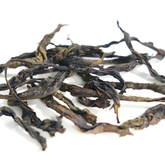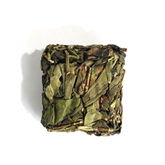Each tea has a perfect brewing method, and the use of correct method will allow the tea to be best-tasted. Some teas need to be brewed using a Chinese lidded bowl (gaiwan), whereas some are steeped in a glass cup. It is winter in China. Tea drinkers would appreciate the use of a stove or a stove-top urn to make the tea, and feeling like sitting around the stove with family members, drinking the hot tea together, was really cozy. Most of all, one must realize brewing vs. boiling tea. Brewing tea is normally done with a teapot or gaiwan; the leaves are steeped without constant heating, where they may turn bitter. On the other hand, boiling tea involves directly heating the tea leaves in water so that they infuse their flavors slowly.
As boiling requires consistent heat, remember that not every tea is a good candidate to be boiled. There are just some teas specifically well-suited to being consumed after being boiled. Having taught more than 100,000 novice tea consumers my art for years, specializing in Chinese culture around tea, I am about to share the methods of utilizing a stove in making tea, and what particular teas should ideally be boiled.
Choosing the Right Tea Utensils
I would highly recommend using dedicated teapot sets intended for boiling tea, and not the regular kettles intended for boiling water. Glass teapots are an excellent choice for the following reasons:
During boiling, clear glass allows you to observe the color change of the tea liquor, which allows you to gauge the strength of the tea.
The glass also allows you to see the tea leaves swirling and dancing, which contributes to the visual effect.
Glass teapots will not affect the flavor of the tea, as they will not absorb any flavor or scent, enabling a cleaner and more stable flavor.
Glass teapots are easy to clean—any tea residue can be easily observed and washed out.
For heating, I suggest the use of an electric ceramic stove for more accurate regulation of the temperature. While charcoal heating can also be used, electric stoves offer a safer, more eco-friendly, and more versatile way of managing the temperature, which is extremely crucial in boiling tea.
Choosing the Right Teas for Boiling
Green tea: Not suitable for boiling
Excellent green tea is prepared from tender young leaves. Heating it at very high temperatures hurts the leaves and causes the green color to change to dark, and the taste to become bitter. The process of brewing green tea emphasizes its fresh, sweet taste, and it must be brewed with water at 80-90°C in a glass or gaiwan. Avoid boiling green tea.
Black tea: Do not boil
Black tea is a completely fermented tea. Because it is fermented so much, boiling black tea will probably give it a sour or astringent taste if timed improperly, overpowering its own natural sweetness. If black tea is boiled, it's generally blended tea, such as with dry flowers or milk. Boiling enhances the taste, but along with it carries a hint of bitterness, which is eased off by the use of sugar or milk.
Oolong tea: Boiling not recommended
Oolong tea is known for its strong floral and fruit aromas combined with the right roasting level. Oolong tea, being as fresh as it is, should not be boiled because boiling destroys its delicate flavor and leaves the tea with a sour bitter astringent taste. To preserve its fresh flavor, oolong tea is best to be quickly steeped in boiling water rather than boiled.
White tea: New white tea must never be boiled, but older white tea is
White tea comes in types like Silver Needle and White Peony, which are optimally brewed rather than boiled. White tea must not be boiled when fresh, as the flavor becomes bitter. But with time, as white tea gets older and the flavor develops, it develops a rich, mellow taste. Aged white tea can be boiled since it aids in releasing the strong, aged taste that makes it unique. White tea may be boiled straight or initially brewed after aging for decades.
Dark tea (Pu'er): The Best Tea to Boil On Stove
Black tea and Pu'er tea (especially ripe Pu'er Tea) are the best teas to boil. These teas undergo long, complex fermentation processes that give them a strong, aged aroma and deep, rich tastes. Boiling Pu'er tea releases its full-bodied taste, so it is the best option for this use.
Tea-to-Water Ratio for Boiling Tea
To make the perfect boiled tea, you need to use the correct tea-to-water ratio. If you use too much tea but too little water, the tea becomes bitter and too concentrated. On the other hand, if you use too little tea, there is no flavor to the tea no matter how long you boil it. The secret is to use the correct proportion. Here is a recommended tea-to-water ratio based on our years of experience:
| Types |
Tea-To-Water Ratio |
| Aged White Tea |
5g/400ml |
| Aged Dark Tea |
4g/400ml |
| Black Tea |
3g/400ml |
Controlling the Boiling Time
Boiling time directly affects the flavor of your tea. Over-boiling will cause the tea to be too bitter, and under-boiling may not release enough flavor. There is no boiling time, but instead, use the tea's color as a guide.
If the tea is too light, it might be too weak.
If the tea is too dark, it might be too strong.
For a delicate flavor, boil the tea for a short time, but for a stronger flavor, boil it for a longer time. As a general rule, it's best not to boil the tea for more than 10 minutes, as this will negatively affect the flavor.
Step-by-Step Guide
Prepare the tea equipment: Clean the glass teapot or ceramic stove.
Measure the tea leaves: Use the recommended tea-to-water ratio.
Rinse the tea leaves: Pour boiling water over the tea leaves to flush out any dust or impurities.
Add water: Pour the amount of water needed into the teapot and heat it to the correct temperature.
Add the tea leaves: Add the tea leaves to the pot when water attains the ideal temperature and begin boiling.
Adjust the heat: Adjust the boiling time and heat according to the type of tea.
Serve the tea: Boil and serve the tea by pouring it in cups. Enjoy and drink.
Important Tips
Water quality matters while boiling tea. Boil with mineral water or filtered water to avoid the flavor interference caused by impurities in normal tap water.
Refill water: If the water in the teapot becomes excessively low while boiling, refill water at once to avoid the tea turning too concentrated and bitter.
Safety precautions: Since the temperature during boiling is 100°C, always be cautious to avoid burns or accidents.
This comprehensive tutorial on how to properly boil tea will allow you to make the tastiest tea possible in your home, perfect for cozy get-togethers and a relaxed tea-drinking experience.
Conclusion
In the cold winter, one of the most pleasant moments is to have the whole family gather around to boil tea. However, it must be noted that teas are not suited for boiling by all means. For example, black tea, green tea, and oolong tea should be brewed, not boiled. The best teas for boiling include aged white tea and black tea, especially mature Pu'er tea.
While boiling tea, the proportion of tea to water and how long to boil need to be controlled. Too much tea is present when the tea turns bitter, and prolonged boiling also affects the taste negatively.









